How To Raise Tadpoles: Beginner’s Guide
Raising tadpoles at home can be a daunting task. Tadpoles are delicate animals. Sudden changes in their environment can be fatal.
Despite the challenges, it’s a rewarding experience for everyone involved. Especially for children. Don’t worry, you’ve found the right place! This guide will show you how to care for tadpoles.
I’ll cover the tank setup, feeding, upkeep, and more. So, let’s get starting by learning how to create a tadpole tank.
Table of Contents
Setting Up A Tadpole Tank
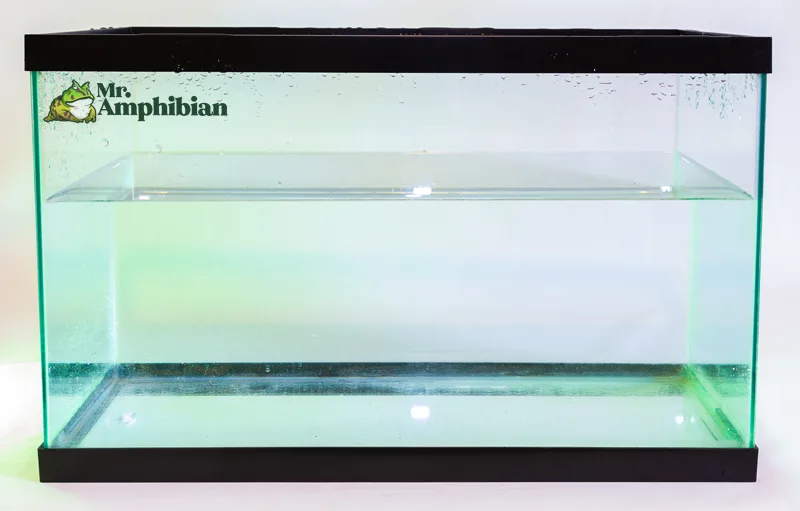
This section will help you create a suitable enclosure for raising your tadpoles. Don’t worry, you won’t need much. In some cases, all you need is a tank/aquarium.
Rocks, gravel, sand, plants, and branches are not required and you don’t need a water filtration system.
Tank / Aquarium
The first thing you need is a container for your tadpoles. Tadpoles, also known as polliwogs, are fully-aquatic so the container must hold water. For this reason, I recommend an aquarium.
You don’t have to use an aquarium. I’ve seen people raise tadpoles in plastic bins. The important part is that you can see the tadpoles and water. Partial water changes are needed to keep the water clean. For this reason, an aquarium or clear plastic container works best.
Your tank needs to be big enough to support all your tadpoles. Also, the smaller the container, the more often you need to change the water.
The last time I raised tadpoles I used a cheap, 10-gallon aquarium. It worked great!
Water
The quality of water and its temperature are important things to get right. Tadpoles are delicate creatures, and a sudden shift in water temperature can spell disaster. Likewise, water containing chemicals like chlorine is harmful.
Water Quality
Water treatment plants typically use chlorine or chloramines to treat drinking water[1]. It’s what most people find in their tap water at home. Tap water is generally considered safe for humans but harmful to amphibians.
Fun fact: Amphibians have permeable skin[2]. This permeability allows frogs to absorb oxygen from the water. It’s also one of the reasons they’re vulnerable to chlorinated tap water.
Do not use tap water without first removing the chlorine. To remove chlorine, let the water sit out for several days before using it. Chlorine evaporates over time and aeration accelerates this process.
Alternatively, you can use a dechlorination agent like Repti-Safe. A few drops of a dechlorination agent will render the water usable. They’re cheap and you can find them in most pet stores or online. It’s a common product in the fish-keeping hobby.
- Bottled spring water is generally considered safe, although it’s not perfect.
- Avoid distilled water because it lacks minerals.
- Rainwater is fine, so long as it’s collected from a source that doesn’t contain chemical runoff.
Pond, lake, or creek water is acceptable under certain conditions. One, don’t use this water if the tadpoles you’re raising are endemic to another part of the world. Local water may contain tiny parasites your tadpoles/frogs aren’t adapted to. Two, ensure the water source is clean. No stagnant, dirty water.
Water Temperature
The temperature of the water is important. It should never change drastically. In other words, don’t toss your tadpoles in an aquarium filled with ice-cold water. This is important to remember when performing partial water changes, but more on that later.
Anurans (frogs and toads) inhabit much of the world, living in varying climates. They all have different requirements. Due to this, the water temperature should reflect what they’re adapted to in the wild. How do you know? You may need to research that.
If you acquired tadpoles from somewhere in the United States, you can most likely keep their water at room temperature. This is because 70 °F water is normal for them.
On the other hand, if you purchase tadpoles from a local breeder and that species naturally inhabits the tropical regions of the world, room temperature might not work.
Plants, Substrate & Decorations
Adding aquatic plants, substrate, and decorations might seem like a good idea. Sure, It’s neat and makes an observation tank appealing. However, decorations are not required and they can cause problems.
- Substrate (rocks, sand, etc) makes cleaning more difficult.
- Large rocks or branches can trap or crush tadpoles.
Be wiery of going overboard. Less is more, in terms of caring for tadpoles. You need to clean their enclosure often, and adding decorations and substrate material can make this a difficult task.
If you simply cannot live without decorations, opt for a fake aquatic plant. They’re easy to move and clean.
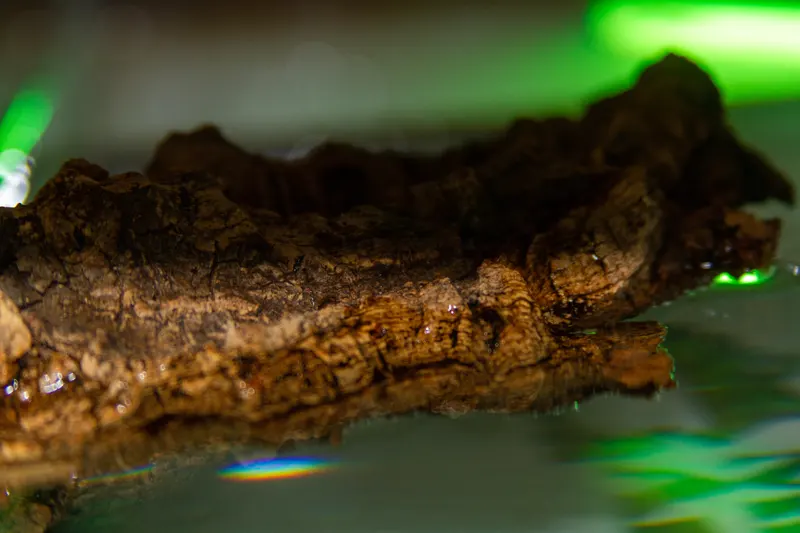
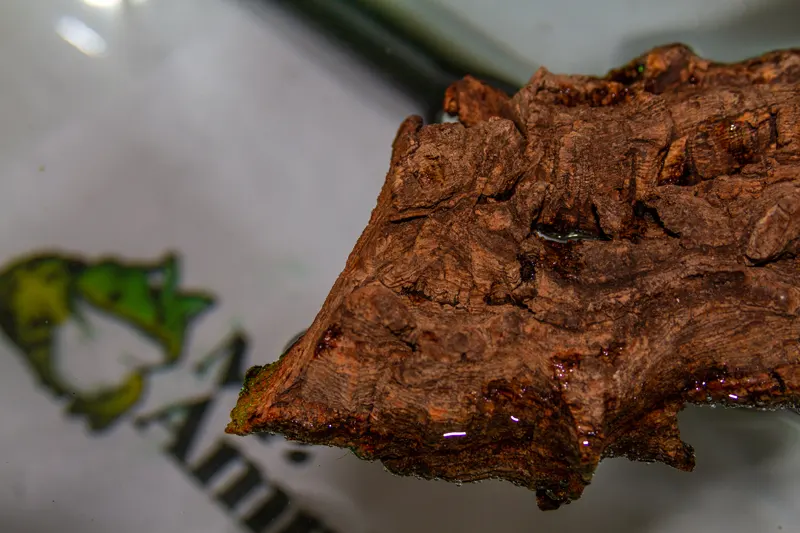
Land Area
Your baby tadpoles will eventually grow legs. They’re becoming semi-terrestrial and need something to walk on. Something to climb in and out of the water, without escaping their enclosure. You don’t need a land area until your tadpoles grow back legs.
You have a few options. Either transfer the tadpoles to a different tank containing a large bowl of water and land area, using a substrate like eco-earth. Or you can place a cork bark flat in their aquarium.
Cork bark floats on water and offers your froglets a place to climb in and out of the water.
Some hobbyists take a simpler approach. They prop one end of the aquarium up. Like this, the slanted aquarium offers a pool of water and land area on opposite sides. It should go without saying but be careful if you do this. You don’t want the aquarium breaking and your tadpoles falling on the ground.
When tadpoles completely absorb their tails, it’s time to transfer them to their final enclosure.
Feeding Tadpoles at Home
Watching tadpoles eat is fun because they’re ferocious eaters. In fact, tadpoles virtually have no homeostatic feedback control before metamorphosis[3]. In layman’s terms, tadpoles eat non-stop until they transform into frogs.
Tadpoles primarily eat plant matter until their gut changes during metamorphosis. As they transition into land-dwelling animals, their gut begins favoring that of a carnivorous diet.
It’s a bit different in captivity. Tadpoles are at your mercy and collecting algae isn’t a reasonable option. So, what do you feed them?
Tadpoles eat the following:
- Boiled baby spinach leaves
- Algae wafers
- Commerical tadpole pellets
- Frozen blood worms
- Hard-boiled egg yolk
- Other nutrient-dense, leafy greens
I’ve had the most success using a combination of boiled, baby spinach leaves and commercial tadpole food.
Boil a pot of water and toss in several baby spinach leaves or other nutrient-dense leafy greens. This softens the greens for your tadpoles. Allow it to cool before feeding to your tadpoles.
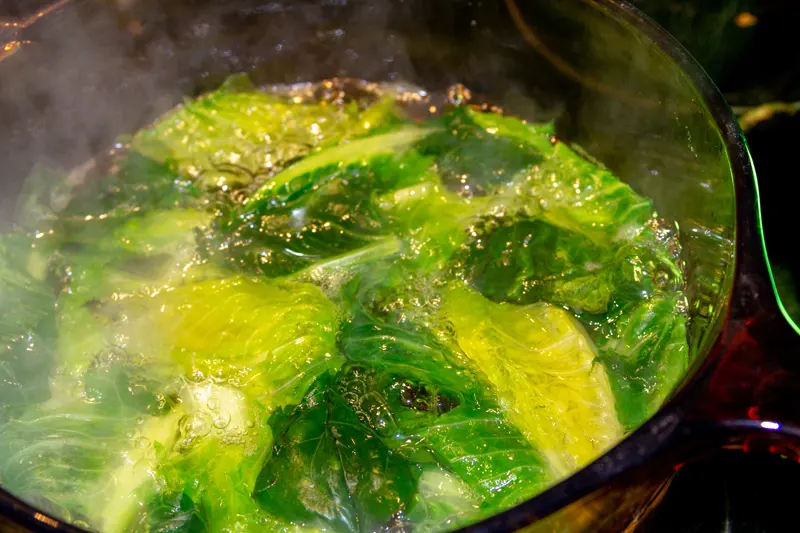
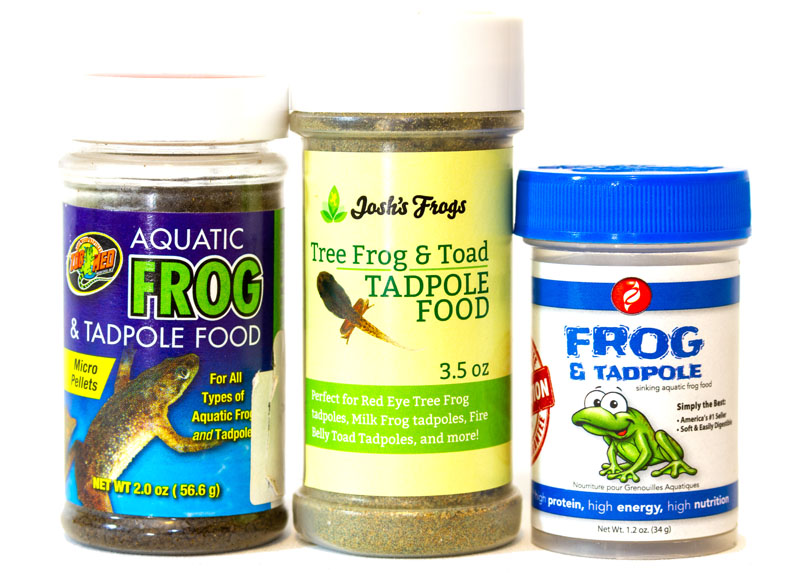
Some hobbyists report great success using the frozen cubes of bloodworms. You can find them in most pet stores, in the aquarium section. Still, I would recommend this in addition to boiled, baby spinach leaves.
Feed your tadpoles 2 to 3 times per day, every day. Be sure there is enough food for all your tadpoles. Remove leftover food after a few hours to help keep the water clean.
I wrote a guide on feeding tadpoles. It covers more information than what is listed here. Consider reading that guide when you finish here.
Tail Resorption & Feeding After Metamorphosis
When tadpoles begin metamorphosis, they stop feeding altogether. Don’t be alarmed. The reason this happens is due to their tail. The process of “resorption” provides the froglet with energy for survival[4].
It’s wise to continue feeding because it’s unlikely that all your tadpoles will enter this phase at the same time.
After metamorphosis, your juvenile frog will begin eating live insects. Again, it’s unlikely that all your tadpoles will be in the same phase at the same time. Continue feeding all tadpoles, both in and out of the water.
For those hopping on land, give them live insects. Two of the best feeder insects for juvenile frogs are:
- Pinhead crickets
- Wingless fruit flies
Feel free to separate juvenile frogs from the tadpoles that are still swimming in the water.
Related: The Life Cycle of a Frog (Activities for Kids)
Cleaning Your Tadpole’s Tank
This section is closely related to water quality, which is important. Raising tadpoles involves a lot of cleaning. They’re messy little animals that basically eat, sleep, and create waste.
Between their excrement and leftover food particles, you will be surprised how fast the water becomes dirty. The water becomes acidic from waste build-up. For that reason, you need to perform partial water changes.
How To Perform A Partial Water Change
You need two large water containers and a small cup. Use the step-by-step guide below.
Steps for performing a water change:
- Fill one container with clean water. Adjust the water temperature to match the temperature in your tadpole’s tank.
- Use the small cup to scoop out approximately 1/3 of the dirty water in your tadpole’s enclosure. Put the dirty water in your second container. Be careful not to scoop out tadpoles.
- Gently pour the clean water into your tadpole’s aquarium.
- Safely discard the old, dirty water.
Keeping the water clean is important. You might need to clean the water every two to three days. It depends on how many tadpoles you’re keeping, the size of the aquarium, and how fast it becomes dirty.
Also, you can reduce the amount of cleaning by removing leftover food three hours after feeding your tadpoles.
Water Filtration System: Yes or no?
Some hobbyists opt for using an aquarium filtration system to help clean the water. I did this with my last batch of tadpoles. Regardless, you will still need to perform partial water changes.
Should you decide to use a water filtration device, there is one thing you must do. You must protect your tadpoles from being sucked into the water intake. This can be accomplished by hiding the intake or covering it with a physical barrier like a filter sponge.
You don’t need a filtration system. You’re perfectly fine without it. Just be sure to perform partial water changes as needed.
My Last Batch of Tadpoles
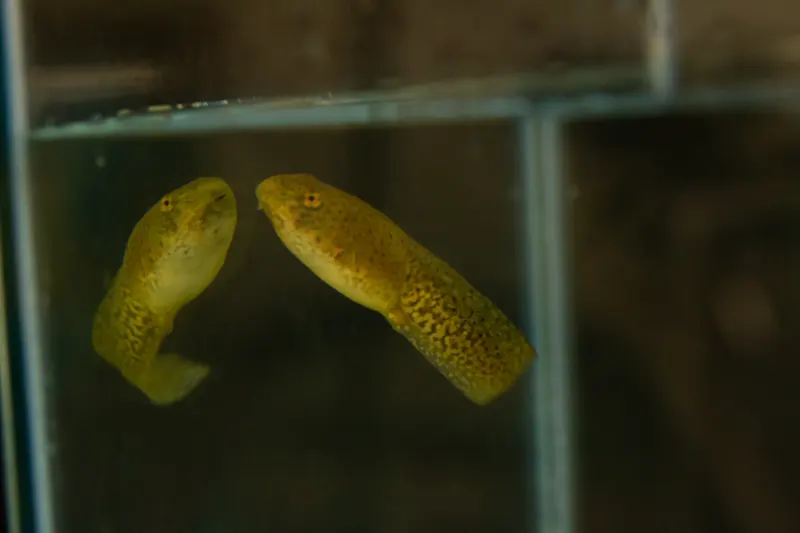
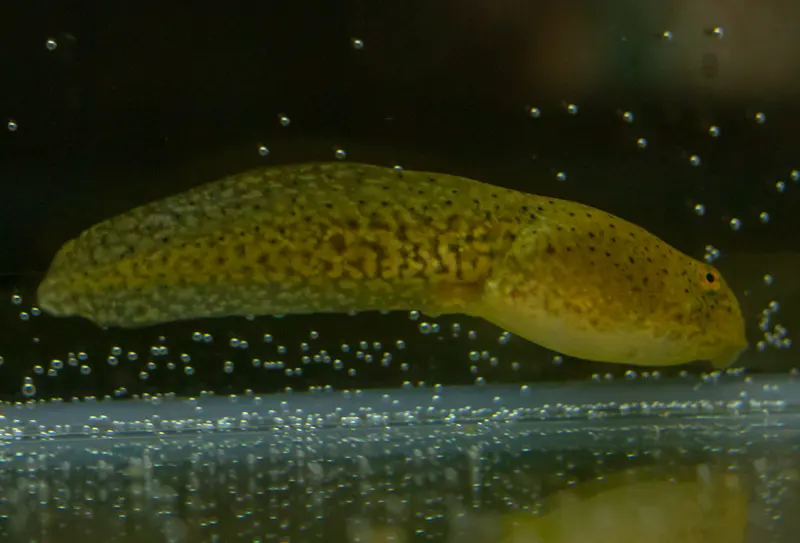
I raised my last batch of tadpoles with my sons. They enjoyed the process quite a bit. Here, I’ll share my experience and struggles so you’ll know what to expect.
We used a cheap, 10-gallon aquarium and filled 3/4 of the tank with water. Room temperature water was adequate for the species of frogs we raised. I placed a water filter in the corner of the aquarium and covered the intake with a filter sponge.
We fed our tadpoles a combination of boiled, baby spinach leaves and commercial tadpole pellets. They clearly favored leafy greens over pellets.
It took about two months for them to grow legs and start hopping on land. During this time, I performed partial water changes every two to three days. I fed them twice per day on workdays and three times per day on the weekend. As the tadpoles grew, I had to clean the water more often.
Around the time they grew front legs, I placed a small piece of cork bark on top of the water. Over the next week or two, I started seeing them climb on it. They’re clumsy at this sage. They have back legs but their tail makes it difficult for them to walk or jump.
Eventually, I transferred them to their final enclosure. The bottom of that enclosure was covered in eco-earth and I placed a large water dish in the middle.
That’s about it. I lost a few tadpoles for unknown reasons. The others were healthy and grew fast.
Where To Get Tadpoles
Now that you know the basics of raising tadpoles, let’s discuss where you can get them. If you’re reading this, chances are you’ve already got tadpoles. That’s fine. Please consider reading this section for future purposes.
There are some legal and ethical issues concerning this topic.
Buying Tadpoles
It is possible to buy tadpoles from local breeders and online for educational purposes. This is the important part: Check with your local government to ensure you’re permitted to do so. There are certain species not permitted in some parts of the world.
Once you’re aware of the local laws and regulations, head over to Facebook and find a local amphibian breeder. Another option is to look online.
I have personally not ordered tadpoles online. It seems like a recipe for disaster. Instead, check out this guide on where to buy reptiles and amphibians. You can use the same steps for buying tadpoles.
Catching Wild Tadpoles
Harvesting frog eggs or tadpoles may seem like a good idea but it poses legal and ethical issues. For this reason, I will give you a disclaimer. I am not an expert and you should not use this website for legal advice. That responsibility falls on you.
Having said that, I did extra research to be as helpful as possible. But first, let’s talk about the amphibian crisis.
Ethical Issues
Frogs are dying off at alarming rates[5]. Among the reasons for declining populations is loss of habitat, invasive species, pollution, and chytrid fungus.
Because of this, taking tadpoles/frog eggs from your environment can have a negative impact on their population. Frogs are truly amazing creatures and they’re in serious trouble.
One can argue that saving a few tadpoles in a shrinking puddle of water on a hot summer day is reasonable and helpful. I tend to agree with this. However, carefully transferring those tadpoles to a nearby pond might be better than keeping them yourself.
Regardless, I wanted you to be aware of the declining population of amphibians so you can make an informed decision. Be sure to read the following section about local laws.
Local Laws
State and local governments have laws and regulations regarding wildlife. It’s your responsibility to understand the laws and regulations.
To be as helpful as possible, I called my state’s wildlife department. The question at hand: “Can I take tadpoles from the wild?” The receptionist paused. “I don’t know, let me get back to you.” And she did. She called back in less than an hour with helpful information.
She explained that some species have special exceptions. For those without exceptions, there is a limit to four frogs per day. But that’s not all. There were certain species completely off-limits. And my state’s regulations don’t specifically mention tadpoles or frog eggs.
You might require a hunting or fishing license, and permission from a landowner to get tadpoles from their property. Again, every state is different. Check your local government’s laws and regulations.
TLDR; How To Raise Tadpoles at Home
Raising tadpoles at home can be challenging. Sudden changes in water temperature can be fatal. Despite this, it’s a good experience for everyone involved.
- You need a tank/aquarium filled with clean, dechlorinated water. The water temperature requirements depend on the species you’re raising. For most species in the United States, water at room temperature will suffice.
- Tadpoles will eat baby spinach leaves, algae wafers, tadpole pellets, bloodworms, and boiled egg yolks. Feed them two to three times per day.
- Perform partial water changes often. This is accomplished by removing 1/3 of the water from their tank and replacing it with clean water. Be sure the water temperature is the same.
Aside from caring for tadpoles, it may surprise you to learn that some state and local laws prohibit people from keeping certain species. It’s best to check your local government regulations.
Featured photo by suwatwongkham/ Adobe Stock
References
- “Water Disinfection with Chlorine and Chloramine | Public Water Systems | Drinking Water | Healthy Water | CDC.” Centers for Disease Control and Prevention, www.cdc.gov/healthywater/drinking/public/water_disinfection.html. Accessed 10 Mar. 2022.[↩]
- Llewelyn, Victoria K., et al. “Permeability of Frog Skin to Chemicals: Effect of Penetration Enhancers.” Heliyon, vol. 5, no. 8, 2019, p. e02127. Crossref, https://doi.org/10.1016/j.heliyon.2019.e02127.[↩]
- Bender, Melissa Cui, et al. “To Eat or Not to Eat: Ontogeny of Hypothalamic Feeding Controls and a Role for Leptin in Modulating Life-History Transition in Amphibian Tadpoles.” Proceedings of the Royal Society B: Biological Sciences, vol. 285, no. 1875, 2018, p. 20172784. Crossref, https://doi.org/10.1098/rspb.2017.2784.[↩]
- Hofrichter, Robert. The Encyclopedia of Amphibians. Adfo Books, 2000., p. 95[↩]
- Adams, Michael J., et al. “Trends in Amphibian Occupancy in the United States.” PLoS ONE, edited by Han Y. H. Chen, vol. 8, no. 5, 2013, p. e64347. Crossref, https://doi.org/10.1371/journal.pone.0064347.[↩]
